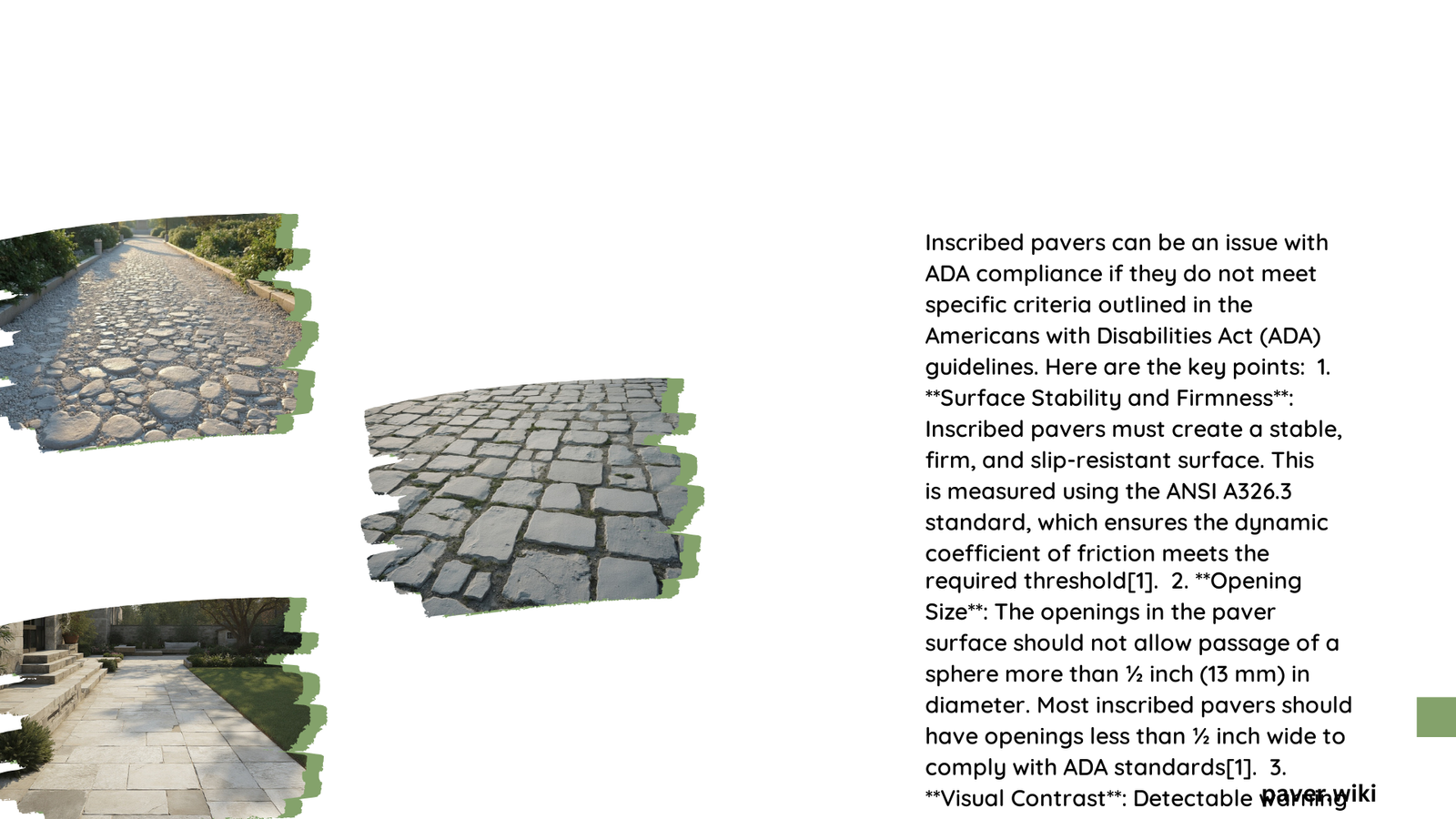Inscribed pavers can present challenges for ADA compliance if not properly designed and installed. Key issues include surface stability, slip resistance, joint widths, changes in level, and the need for detectable warning surfaces. Compliance requires careful attention to material selection, installation techniques, and ongoing maintenance to ensure accessibility and safety for all users.
What Are the Specific ADA Compliance Issues for Inscribed Pavers?
When considering inscribed pavers in relation to ADA compliance, several key issues must be addressed:
- Surface Stability and Slip Resistance:
- Pavers must be stable, firm, and slip-resistant
- Measured using ANSI A326.3 American National Standard Test Method
-
Dynamic coefficient of friction should be at least 0.42
-
Openings in Floor and Ground Surfaces:
- Openings between pavers should not allow passage of a sphere more than ½ inch (13 mm) in diameter
-
Joints between pavers typically should be no larger than ½ inch wide
-
Changes in Level:
- Should not exceed ¼ inch (6.4 mm) high
- Larger changes require ramps
-
Installation process must ensure minimal height variances
-
Detectable Warning Surfaces:
- Required for transitions between pedestrian and vehicular areas
- Must have truncated domes with specific dimensions:
- Base diameter: 0.9-1.4 inches (23-36 mm)
- Top diameter: 50-65% of base diameter
- Height: 0.2 inches (5 mm)
- Placed on a square grid with center-to-center spacing of 1.6-2.4 inches (41-61 mm)
How Do Safety Regulations Address Quantifiable Risks?

Safety regulations for inscribed pavers aim to prevent hazards and ensure accessibility:
- Slip Resistance:
- ANSI A326.3 test ensures dynamic coefficient of friction of at least 0.42
-
Reduces risk of slips, trips, and falls
-
Tripping Hazards:
-
Openings between pavers limited to ½ inch (13 mm) to reduce tripping risk
-
Changes in Level:
- Vertical changes limited to ¼ inch (6.4 mm) to prevent tripping and falling
-
Proper installation and use of ramps for larger changes
-
Detectable Warning Surfaces:
- Crucial for safety of visually impaired individuals
- Correct installation and maintenance vital
What Accessibility Standards, Materials, and Design Techniques Should Be Used?
To ensure ADA compliance, consider the following:
Materials
- Use firm, stable, and slip-resistant materials
- Interlocking concrete and permeable pavers often meet criteria when properly installed
Design Techniques
- Installation:
- Install on stable base (aggregate or concrete)
- Compact to prevent height variances
-
Use bedding layer to adjust for paver thickness variations
-
Joint Widths:
-
Maintain widths of no more than ½ inch (13 mm)
-
Detectable Warning Surfaces:
- Use truncated domes meeting specified dimensions and spacing
-
Ensure visual contrast with adjacent walking surfaces
-
Wheelchair User Comfort (optional):
- Consider pavers with micro-chamfers and smooth or low-profiled textures
What Are the Cost Implications and Timing Factors?
Ensuring ADA compliance for inscribed pavers involves several cost and timing considerations:
Costs
- Initial Costs:
- Proper installation of ADA-compliant pavers can be more expensive
-
Includes specialized materials and knowledgeable labor
-
Penalties for Non-Compliance:
- First-time violation: Up to $55,000
- Subsequent violations: Up to $150,000
-
Potential litigation costs
-
Maintenance Costs:
- Regular checks for slip resistance, joint widths, and condition of detectable warning surfaces
Timing Factors
- Crucial to ensure compliance during design and installation phase
- Working with knowledgeable contractors and suppliers can streamline process and prevent delays
How Can Inscribed Pavers Be Made ADA Compliant?
To make inscribed pavers ADA compliant:
- Select Appropriate Materials:
- Choose pavers that meet slip resistance standards
-
Ensure materials are firm and stable
-
Proper Installation:
- Use a stable base and proper compaction techniques
-
Maintain correct joint widths and level surfaces
-
Incorporate Detectable Warning Surfaces:
- Install truncated domes at pedestrian-vehicular transitions
-
Ensure proper dimensions and spacing
-
Regular Maintenance:
- Conduct periodic checks for slip resistance and surface stability
-
Repair or replace damaged pavers promptly
-
Consult Experts:
- Work with ADA compliance specialists during design and installation
- Conduct regular audits to ensure ongoing compliance
By following these guidelines, inscribed pavers can be successfully integrated into ADA-compliant designs, providing both aesthetic appeal and accessibility for all users.
References:
1. ADA Standards For Accessible Design – Belgard Commercial
2. Accessible Clay Brick Pavements – Brick Industry Association
3. Defining ADA-Compliance for Interlocking Concrete and Permeable Pavers – Techo-Bloc
